This task shows
you how to create a 2D mesh part by extracting face elements of an existing
3D mesh part.
You will then generate 2D elements.
For more details about the 2D elements, refer to the Finite Element
Reference Guide.
You can extract 2D elements from Octree Tetrahedron Mesh part, Tetrahedron Filler part or any 3D transformed mesh part.
-
This functionality is only available with the FEM Solid (FMD) product.
-
The 3D mesh parts must be updated.
Open the Sample16.CATAnalysis document from the sample directory.
-
Update the 3D mesh parts.
To do this, right-click Nodes and Elements and select Update All Meshes.
-
Click the Coating 2D Mesh icon
 in the Mesh Transformations toolbar.
in the Mesh Transformations toolbar.The Coating 2D Mesh dialog box appears.
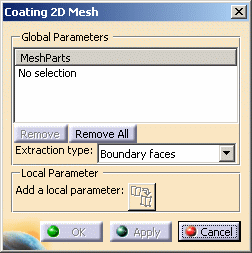
- Global Parameters:
- Mesh Parts: lets you select the 3D mesh parts from
which you will create the 2D mesh part.

- Multi-selection of 3D mesh parts is available.
You can select Octree Tetrahedron Mesh part, Tetrahedron Filler part or any 3D transformed mesh part. - The 3D mesh parts must be updated.
To do this, right-click Nodes and Elements and select Update All Meshes.
- Multi-selection of 3D mesh parts is available.
- Remove: lets you remove a selected mesh part.
- Remove All: lets you remove all the selected mesh parts.
- Mesh Parts: lets you select the 3D mesh parts from
which you will create the 2D mesh part.
- Extraction type: lets you specify the face element
you want to extract to create a 2D mesh part.
- Boundary faces: each boundary face of the solid mesh parts will generate a surface element.
- None: only the local specifications will be used to generate 2D elements.
- Correspondence between solid elements and extracted surface
elements:
Solid elements
Extracted elements
TE4
TR3
TE10
TR6
HE8
QD4
HE20
QD8
WE6
TR3
QD4WE15
TR6
QD8
- Local Parameter:
- Add a local parameter
 :
lets you include or exclude elements.
:
lets you include or exclude elements.
This button is available as soon as you select a 3D mesh part.
- Add a local parameter
This button lets you display the Coating 2D Specification dialog box.
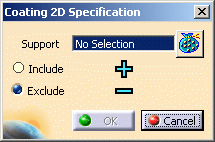
- Support: lets you select one or several faces you
want to add or remove locally from the set of face elements you
want to extract. You can also select groups created under a
mesh part.

-
You can only select 2D geometries or 2D groups as local specification supports.
This support must have the same dimension as the elements you want to extract. -
Multi-selection of supports is available.
To do this, select in sequence the faces or groups you want to ignore or constrain. -
You can only select groups that belong to the mesh parts you selected in the Global Parameters.
- Include: lets you select one or several faces (or groups of faces) you want to add to the set of faces you will extract.
- Exclude: lets you select one or several faces (or groups of faces) you want to remove from the set of faces you will extract.
-
- Global Parameters:
-
Select a 3D mesh part.
In this particular example, select Tetrahedron Filler Mesh.1 in the specification tree.
-
Select Boundary faces as Extraction type option.
-
Click Apply in the Coating 2D Mesh dialog box.
The Coating 2D Mesh.1 feature now appears in the specification tree.
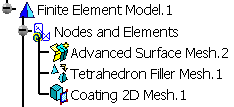
The extracted faces are displayed on the geometry.

For a better visualization, hide the existing mesh parts and the geometry using the Hide/Show contextual menu.
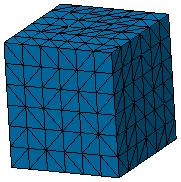
-
Click the Add/Remove Mesh button
 in the
Coating 2D Mesh dialog box.
in the
Coating 2D Mesh dialog box. -
Select faces directly on geometry.
In this particular example, select four faces.
Note that you have to show the geometry to select faces using the Hide/Show contextual menu. -
Click the Geometry Selector
 button to
visualize the faces you selected.
button to
visualize the faces you selected.The Geometry Selector dialog box appears.
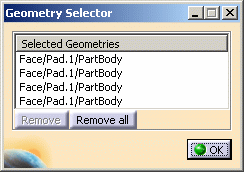
-
Click OK in the Geometry Selector dialog box.
-
Click Exclude in the Coating 2D Specification dialog box.
-
Click OK in the Coating 2D Specification dialog box.
-
Click Apply and then OK in the Coating 2D Mesh dialog box.
The Coating Local Specification.1 feature now appears in the specification tree under the Coating 2D Mesh.1 mesh part.
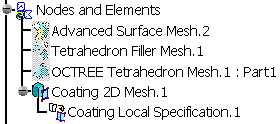
The 2D mesh part is displayed on the geometry. For a better visualization, hide the geometry.
